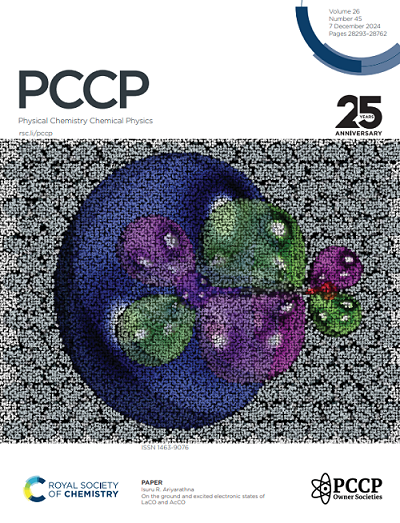Optical gaps of F-center defects in LiF using many-body methods
IF 2.9
3区 化学
Q3 CHEMISTRY, PHYSICAL
引用次数: 0
Abstract
F-center defects, occuring in technologically important wide-bandgap solids, influence the properties of the parent material. Their experimental characterization can be challenging due to low concentrations and spectral broadening. Modeling of these defects poses computational challenges due to their aperiodic nature, lattice distortion effects, and the need to describe many-body polarization effects induced by the surrounding environment. Here, we study bulk and surface F-center defects in LiF by combining random phase approximation (RPA) based potentials with periodic electrostatic embedding. We evaluate the accuracy of computationally efficient potentials such as single-pole exchange-correlation (1p-XC) and static-Coulomb hole screened exchange (st-COHSEX), and find the former to be suitable for bulk and surface F-center defects. For the commonly studied case of bulk F-centers, the 1p-XC approach predicts an optical gap (Δog) of 5.24 eV, closely matching high-level quantum chemistry methods like CASPT2 (Δog=5.31 eV) and within 0.16 eV of experimental absorption maximum. For surface F-centers, which are largely unexplored, we find a significantly lower optical gap of 1.85 eV. The smaller gap arises from reduced confinement effects and significantly larger lattice relaxation induced by surface F-center defect compared to bulk. On the other hand, the polarization corrections to the optical gaps are similar for both cases.用多体方法研究LiF中f中心缺陷的光学间隙
f中心缺陷发生在技术上重要的宽带隙固体中,影响母材的性能。由于低浓度和光谱展宽,它们的实验表征可能具有挑战性。由于这些缺陷的非周期性、晶格畸变效应以及需要描述由周围环境引起的多体极化效应,对这些缺陷的建模提出了计算挑战。本文采用随机相位近似(RPA)电位与周期性静电嵌入相结合的方法,研究了LiF的体和表面f中心缺陷。我们评估了单极交换相关电位(1p-XC)和静态库仑孔屏蔽交换电位(st-COHSEX)的精度,发现前者适用于体和表面f中心缺陷。对于通常研究的体f中心,1p-XC方法预测的光隙(Δog)为5.24 eV,与CASPT2等高级量子化学方法(Δog=5.31 eV)非常匹配,并且在实验吸收最大值的0.16 eV范围内。对于表面f中心,我们发现其光学间隙明显较低,为1.85 eV。与块体相比,更小的间隙是由于约束效应的减少和表面f中心缺陷引起的晶格弛豫。另一方面,两种情况下对光学间隙的偏振校正是相似的。
本文章由计算机程序翻译,如有差异,请以英文原文为准。
求助全文
约1分钟内获得全文
求助全文
来源期刊

Physical Chemistry Chemical Physics
化学-物理:原子、分子和化学物理
CiteScore
5.50
自引率
9.10%
发文量
2675
审稿时长
2.0 months
期刊介绍:
Physical Chemistry Chemical Physics (PCCP) is an international journal co-owned by 19 physical chemistry and physics societies from around the world. This journal publishes original, cutting-edge research in physical chemistry, chemical physics and biophysical chemistry. To be suitable for publication in PCCP, articles must include significant innovation and/or insight into physical chemistry; this is the most important criterion that reviewers and Editors will judge against when evaluating submissions.
The journal has a broad scope and welcomes contributions spanning experiment, theory, computation and data science. Topical coverage includes spectroscopy, dynamics, kinetics, statistical mechanics, thermodynamics, electrochemistry, catalysis, surface science, quantum mechanics, quantum computing and machine learning. Interdisciplinary research areas such as polymers and soft matter, materials, nanoscience, energy, surfaces/interfaces, and biophysical chemistry are welcomed if they demonstrate significant innovation and/or insight into physical chemistry. Joined experimental/theoretical studies are particularly appreciated when complementary and based on up-to-date approaches.
 求助内容:
求助内容: 应助结果提醒方式:
应助结果提醒方式:


